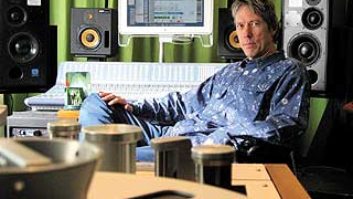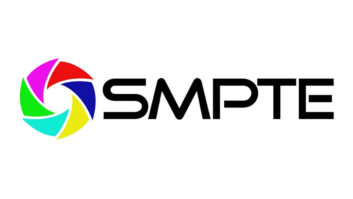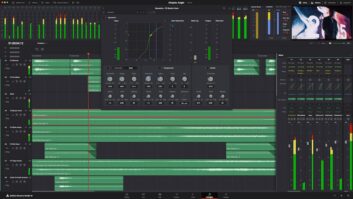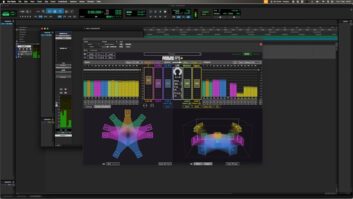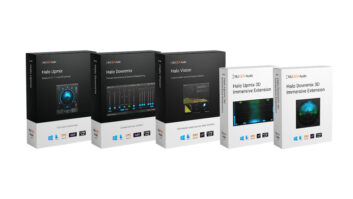
DTS HD sounds best encoded at 1,509 Kb/sec.
Creators of audio content for consumer video and audio platforms have always had to deal with a list of do’s and don’ts. As formats evolved, the list got longer, as did the learning curve. Early CD authors were presented with digital zero, 16-bit/44.1kHz and stereo PCM. Then came DVD and DVD-A, which brought 5.1/6.1 channels, DTS, Dolby Digital, 96kHz sample rate and MLP lossless. And so it goes with Blu-ray, the latest format to change the game for content creators. With the increasing importance and consumer acceptance of this new medium, let’s explore some of the possibilities and the limitations that the latest high-definition disc has to offer.
Outstanding Possibilities
Blu-ray’s audio and video specs are fantastic. The disc supports up to 32 different bitstreams for primary and 32 bitstreams for secondary audio, plus up to 16 MB for tertiary audio clips used in menu and button sounds. Bitstreams support any number of channels (mono, stereo, 5.1, 7.1 and more) using PCM, Dolby and DTS formats. There is also support for 96- and 192kHz audio sample rates. (There is no support for 44.1 or 88.2.)
An impressive example of Blu-ray’s capabilities is on the film Harry Potter and the Order of the Phoenix, with 14 (yes, 14) 5.1 channel bitstreams, 13 different languages and 27 subtitle streams. In this title, Warner Home Video chose to have two English 5.1 channel mixes, in both raw PCM and Dolby Digital legacy, along with 12 other languages including Spanish and Castilian (Español and Castellano), European and Canadian French, German, Italian, Dutch, Japanese, Danish, Swedish, Catalan and Flemish. Now that’s some authoring!

DTS Master Audio Suite uses straightforward entry screens.
On the video side, a dual-layer, 50GB Blu-ray can store up to nine hours of HD feature content (1,920×1,080 resolution) and up to 23 hours of SD content (720×480). A Blu-ray disc’s maximum sustainable data transfer rate is 48 Mb/sec, with the video part of that max limited to 40 Mb/sec. With variable bit rate encoding on both audio and video, audio could hit peak rates well above 8 Mb without affecting video quality at all.
However, before this stellar bit rate can be spun into the consumer’s player, some questions should be answered. For instance: Should you give priority to the analog or digital outs? Should you send the original bitstream (only HDMI 1.3 or later) or a PCM stereo downmix to your HDMI output? Do you want any 96kHz sample-rate content down-sampled to 48 kHz for your digital out? These questions go on and on, and it’s important that creators pay attention to these critical details — otherwise, consumers could end up with poor to downright annoying results.
For example, a stereo mix must be designated for LCRS (matrix or Dolby Pro Logic) decoding or straight through stereo intended for Left Front/Right Front playback. This is done via metadata flags known as Lt/Rt or Lo/Ro to indicate how audio playback should properly decode. Lt/Rt means “Left Total/Right Total” and is the indicator for surround sound (LCRS) decoding; Lo/Ro is the indicator for Left Only/Right Only decoding. Because industry authoring deals mostly with feature content, many hardware and software encoders, or the procedure within the authoring/compression departments, will default to Lt/Rt if not specified. In this case, our straight stereo mix’s phantom center would cancel out of the Left and Right playback and instead be directed to the consumer’s center channel and inadvertently decoded in LCRS surround mode. This actually occurred in a Steely Dan concert video DVD a few years ago. Now with Blu-ray’s bevy of features, attention to this kind of detail is even more critical.
What’s on First, Who’s on Second
Blu-ray’s primary audio bitstreams are designated to the main soundtracks. This is really where the “sky’s the limit.” Currently, up to eight channels of any configuration (8.0, 7.1, 6.1, 5.1, 5.0, LCR, 2.0) down to mono are completely supported using PCM, Dolby or DTS formats. There are some channel limits with a 192kHz sample rate.

Dolby Media Meter analyzes the mix for overall levels.
Secondary audio is designed primarily to accommodate director/actor commentary-type tracks, but it also offers some very cool options. DVD content creators had to make many tough decisions due to space and bandwidth limitations. Commentary tracks were usually encoded in stereo or Dolby Digital 2.0 instead of 5.1 to save space and were separate bitstreams. With Blu-ray, any number of commentary tracks can be encoded in Dolby Digital Plus or DTS Express in mono or stereo as secondary audio. (Due to limited bandwidth, PCM is not possible.) Not only is this secondary audio simply added to the primary audio mix (by user selection), it can be authored to do so on-the-fly, meaning through a pop-up menu while the feature is still playing. Blu-ray’s specs require that the player be capable of mixing these sounds together, yet a secondary or tertiary track’s sounds could be dropped, depending on player settings for co-ax or optical digital outputs. The big advantage here is commentary tracks no longer require another primary soundtrack as in DVD, allowing for more creative options with significantly less file size and bandwidth.
In addition to bringing this mono or stereo commentary track into the mix, what is called “AAF” metadata can be encoded into the secondary bitstream that allows fader moves of any and all channels in the primary mix. One can “ride faders” that reduce the primary audio level creatively around the commentary dialog and export that automation for inclusion in the secondary bitstream. When using this feature, the overall level of the primary audio can be adjusted +12 to -50 relative dB in 1dB increments, but any individual channel adjustment is limited to -28dB relative differential from the rest. Using metadata, the channels can be routed to any supported output in someone’s home theater/player system setup (i.e., not necessarily center or L/R). I can’t wait for someone to have the director talk over my shoulder in the surrounds. With Blu-ray, this is possible.
PCM With Reservations
Although Blu-ray supports PCM in any bit depth up to eight channels at 48kHz or 96kHz sample rates, or up to six channels at 192 kHz, there are two caveats about using PCM.
First, PCM requires at least double the file sizes as compared to using even the highest-quality, lossless features of both Dolby and DTS. Second, even if you have plenty of room on a 25- or 50GB disc, you lose many important features. The ability to set “dialnorm” (dialog normalization) and downmix options is only available when your content of any number of channels is “bundled” within a Dolby or DTS bitstream.
Not having the ability to set dialnorm significantly changes the game for both the consumer and the author. For instance, it may cause the end-users to alter their volume knob constantly due to the likelihood that different mixes from different sources can exhibit more drastic level differences than you might expect. At the production end, Blu-ray authors and their audio staff can simply adjust dialnorm settings as the audio content is encoded using any of the Dolby or DTS technologies. When using PCM, the authors would have to add what could be unfeasible workflow delay issues to kick the various audio mixes back to content-creation personnel to re-adjust audio levels for consistent playback from all the various content.
Also, when using PCM for multichannel tracks, one is at the mercy of the player manufacturer’s default for downmixing. When either Dolby or DTS is used to encode multichannel mixes, metadata can be set by content creators through their compression (encoding) and authors as to exactly how they would like downmixes to be executed. This includes specifying how a 7.1 or 6.1 mix should be downmixed into 5.1, and how that resulting downmix should be presented when downmixed into stereo.
DVD vs. Blu-ray
The new Dolby and DTS extensions for Blu-ray are quite impressive. Both offer lossless encoding formats up to 24-bit/192kHz via DTS Master Audio and Dolby TrueHD. Both offer extra (beyond 5.1) channels with very high-quality lossy formats: DTS-HD and Dolby Digital Plus.
In the past, legacy Dolby Digital, AC3 bitstreams were limited to 448 Kb/sec on DVD. Legacy Dolby Digital always had a maximum transfer (or data rate) of 640 Kb/sec, but this was not supported on DVD specifications. No such limit exists for Blu-ray. Using their (legacy) AC3/Dolby Digital 5.1 at 640 Kb/sec makes a huge difference over the 384Kb or even the 448Kb rates available on DVD. For a Blu-ray that needs many 5.1 bitstreams, they still take up comparably small space vs. the Dolby Tru-HD. So if a content creator wanted multiple 5.1 mixes in various languages, both DTS and Dolby legacy formats could make a huge difference, allowing many 5.1 mixes to fit nicely on Blu-ray.
DTS’ legacy format, Coherent Acoustics (at its full 1,509 Kb/sec), was and still is available for DVD, as well as the 768Kb/sec version; i.e., both DVD and Blu-ray. So keep in mind that a Legacy DTS at 768 Kb/sec or a Legacy Dolby Digital AC3 stream at 640 Kb/sec — both supporting up to 6.1 channels — could come in very handy for lots of alternate-language multichannel bitstreams (tracks). On DVD, most creators only had room for encoded 2-channel downmixes for alternate languages. DVD maximum was eight audio bitstreams.
Dolby or DTS?
Although Dolby and DTS are different in their approaches, both companies offer transparent delivery of original master recordings for Blu-ray. On DVDs, many “golden-eared” audio/recording engineers creating 5.1 mixes were amazed at the Coherent Acoustics algorithm employed by DTS, even at their (half) speed of 768 Kb/sec. I would always recommend the full 1,509 Kb/sec for client’s music or concert video 5.1 content, where total space was not a problem. Now, with the high-resolution and lossless options for Blu-ray, the sonic differences are perhaps even less than subtle, or nonexistent.
This doesn’t mean there aren’t some differences. DTS has an interesting advantage for Blu-ray, in that the DTS bitstream was structured to always have DTS’ legacy 5.1 48 kHz (known as “Core”) embodied in its new formats, thus saving space. Dolby Digital’s new TrueHD format uses the company’s previous MLP (Meridian Lossless Packing) technology from the DVD-A specification; then for Blu-ray compatibility, a simultaneous AC3 (legacy) encode is required and is additive to the final file size.
While DTS is marketing this point as an advantage, the reality is that a compatible Dolby TrueHD bitstream typically adds only about 10 to 15-percent more data. This would result in about 400 extra MB on a file for a 2.5-hour feature that is already 3 to 6 GB. This would only be significant if someone was right at the 25GB (single) or 50GB (dual-layer) limit and needed a digital “shoehorn” option without sacrificing the “lossless” feature.
On the Dolby side, the advantage is seen in the Dolby Media Meter plug-in found in the company’s offerings of encoding and editing tools. Using this awesome tool, you can analyze any existing mix for overall levels against industry-standard dialnorm, which is -27 dBFS. As I mentioned above, due to Blu-ray’s much larger data capacity, content creators are including a lot of extra bonus material and dealing with different feature mixes, language overdubs, etc., all of which can have dramatically different overall levels. Dolby Media Meter can run faster than real-time analysis, whose result is a recommended dialnorm setting for that particular content. This application can run stand-alone or as an RTAS/AudioSuite plug-in in Pro Tools, among other platforms. It’s also available for separate purchase from Dolby and can be invaluable for consistent levels over an entire Blu-ray disc’s audio content.
Whatever format you use to author to Blu-ray, you can be sure that you’ll have an abundance of great tools to access the deep feature set that Blu-ray discs offer. The bottom line is stellar picture and sound in numerous languages with lots of extra features and resources. What’s not to like?
For more info on Blu-ray authoring, be sure to read Mix‘s review of the Dolby Media Producer software suite at mixonline.com/gear/reviews/audio_dolby_media_producer_2.
Glen O’Hara is an engineer and educator who has produced 5.1 music titles on DVD-A and DTS audio discs.
